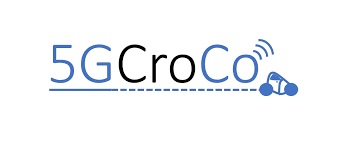5GCroCo 5G Cross-border service continuity for CAM

Overview of the 5GCroCo trial on 5G Cross-border service continuity for CAM
Services such as High-Definition (HD) Mapping and Anticipated Cooperative Collision Avoidance (ACCA) for Connected and Automated Mobility (CAM) applications demand uninterrupted network connectivity. In Europe, where Mobile Network Operators (MNOs) usually only serve a single country, this is especially challenging when driving through national borders. Currently, vehicles search and register with an MNO in the country they enter, only after the MNO connection in the country of origin is lost, which can interrupt the service for several minutes. With CAM service continuity being key, e.g. for safety reasons, this situation is clearly not acceptable.
5GCroCo is one of several 5G PPP research projects funded under Horizon 2020 focused on cross-border/-MNO handover enabling seamless service continuity at country borders. As such, it has deployed a large-scale test and trial network in the border between Germany and Luxembourg. The trials were conducted between October 2020 and March 2021 by Ericsson, Orange, Volvo and the Forschungsgruppe Verkehrstelematik research group at the HTW Saar University of Technology, among others, to evaluate the HD Mapping and ACCA use cases. The necessary exchange of information is carried out through designated interfaces so that a user can be handed over between the networks in two different countries, such as a border crossing just as a regular hand-over takes place between two MMEs (mobility management entities) in the same network when traveling in a single country.
5G Empowerment
This 5GCroCo Trial was conducted on a rural road between the towns of Remerschen and Schengen. Two Non Standalone (NSA) 5G networks were deployed (Remerschen POP 5G and Tunnel 5G). The user plane nodes of the two network cores were deployed in the city of Luxembourg and the control plane nodes were located in an Ericsson lab in Aachen, Germany. The backend servers were physically residing in Frankfurt, Germany. Regarding the used spectrum, the 3.7GHz band was used for 5G coverage with 40 MHz bandwidth in TDD mode while the 700 MHz band was used for the 4G anchor cells, which used 10 MHz for both the uplink and downlink.
The trial successfully showed that cross-border service continuity is feasible for both the HD Mapping and ACCA use cases thanks to the developed cross-border/-MNO handover. For example, cross-border handover allowed for seamless service continuity for HD map download: the green/red tiles indicate successful/failed HD Mapping download, respectively. When cross-border/-MNO handover was enabled, there were no service interruptions, whereas when no cross-border/-MNO handover was enabled the service was interrupted for about a minute.
5G Key Performance Indicators
5G technology used in this trial enables:
- Reduced latency, e.g., 13 ms at percentile 99 compared to 30 ms in 4G for ACCA. Higher throughput of 5G through increased spectral efficiency and available mid-band spectrum, and the MEC-enabling can further reduce latency.
- Optimised 5G RAN configuration for the HD Mapping and ACCA use cases, E2E QoS management, QoS prediction, precise positioning, cross-domain Management and Orchestration (MANO) and Software Defined Networking (SDN) together with network slicing.
Videos and Demos
A video on earlier tests and trials for the ACCA use case at the Montlhéry Test Site is available here (December 2020).
Accolades
One of the ten winners of the 2021 5G-IA Trials Working Group annual competition, featuring in the 5G Infrastructure PPP Brochure - Trials and Pilots.
Use Case Data Summary
Locations: Remerschen and Schengen, near the point where the borders of Germany, France and Luxembourg come together.
Dates: October 2020, March 2021
Partners involved: Ericsson, Orange, Volvo, HTW Saar University of Technology
EC funding reference: Horizon 2020; ICT-18-2018: 5G for cooperative, connectec and automated mobility (CCAM)
Funding cycle: November 2018-June 2022
Discover more and join the 5GCroCo community
Website | Twitter: @5GCroCo | LinkedIn | YouTube
